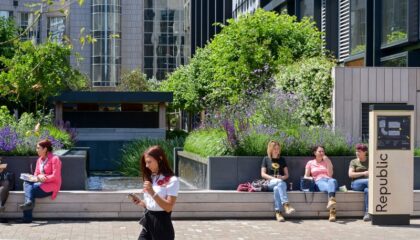The post-pandemic shift towards hybrid working has meant fluctuating numbers of people in workspaces throughout the week. The challenge for property managers is to devise creative solutions that mean buildings remain inviting, without wasting valuable resources, Eleanor Newton, Senior Associate, writes in This Week In FM.
Employees who can work remotely have saved time and money – and have often increased productivity – by not commuting to city-centre offices every day.
For employers, the recognition that increased work-life balance is an enticement for talent, not to mention the cost efficiencies of hybrid working, is prompting an evolution of workspace strategies which is swiftly being written into company policy.
Now, more than half of all UK employees (57%) will work from home some of the time – more than double compared with pre-pandemic levels, according to the Office of National Statistics.
Such a wholesale shift to hybrid working patterns means property managers could be deploying services unnecessarily – such as the daily clean of a workspace that’s been unused for days or a substantial reception team based on 2019 occupancy levels, with implications for energy consumption, overheads, or both.
But there are innovative solutions available, especially when properties are treated on a case-by-case basis.
DATA: Utilise occupancy data to create bespoke solutions for hybrid working
One vital component is data. Footfall counters and access data are now utilised more avidly than pre-Covid, and provide valuable insight into attendance patterns. Armed with information, it’s possible for property managers to make significant changes to services, spaces, and utilities provided. It’s often possible to work with occupiers to ask employees to streamline occupancy patterns so that resources are not wasted, and energy consumption is kept under control.
Technology such as PIR sensors, indoor air quality sensors and intelligent building operating systems can also help manage this, providing property managers with granular data on how buildings are being used, and adapting plant controls accordingly. In conjunction with ESG goals, already significant drivers in reducing plant run times and energy consumption, with energy costs soaring, monitoring and controlling buildings closely is also saving occupiers money. Smart building data from tools such as IBOS can also be used to convey factors such as indoor air quality, which can be displayed via an app, or on display screens at lift lobbies, for example, to help allay lingering Covid-related nervousness about returning to offices.
And where occupancy data is applied to services such as cleaning and reception teams, contractors can focus on days of higher occupancy. This helps with reducing service charge costs for occupiers, but still ensures that on busy days, service levels are kept to the same standards as pre-Covid. On sites where food and beverage outlets operate, occupancy data helps support retailers in planning stock levels.
COMMUNICATION: Ask occupiers to outline employee needs
A key strategy is to keep talking to occupiers, with regular meetings – preferably held onsite. This helps property managers understand the differing needs of various occupiers, and the kinds of activities or events that would be popular as drivers to encourage people back into offices. For example, the Welcome-managed portfolio, including Westside, a Hemel Hempstead business park, recently ran a Sustainability Week which encouraged occupiers’ employees back into offices to meet face-to-face for social activities. Special activities and events were primarily organised on days with higher levels of occupancy, but also occasionally on days where occupancy is usually lower, giving employees a reason to come in.
Improvements to the environment in and around buildings is also helping encourage people back. At Republic, a mixed-use office campus in East London, additional amenities such as a multifaith room have been added after consultation with occupiers and their employees about the sorts of services on site that would compete with what they have when working from home.
SUPPORT CHANGE: Recalibrate the space
It’s a common story that occupiers are reconfiguring office space to create more meeting rooms for collaborative working. It’s in a property manager’s interest to support occupiers to do this to make spaces suit their needs for longer.
For one occupier of two floors at a Stratford building, the property management team worked with the landlord to grant consent for a staircase between the two floors with auditorium style seating to accommodate town hall-style meetings. Conversely, some landlords are subdividing spaces and letting them to micro-companies or new start-ups. At Republic, incubator spaces have been created to attract different types of small businesses and entrepreneurs; companies who would have previously found the space available in the buildings far too large. Several of these new businesses have since expanded and taken more space.
The ebb and flow of activity means today’s property managers need to carefully plan the provision of services and resources to meet occupiers’ needs – and must rely on an arsenal of tools and strategies that empower them to respond to fluctuating demand. The role of today’s property manager no longer stops at the occupier’s door, but – like a five-star hotel – the service must go all the way to the customer.
By Eleanor Newton, Senior Associate

This article first appeared in This Week in FM.



